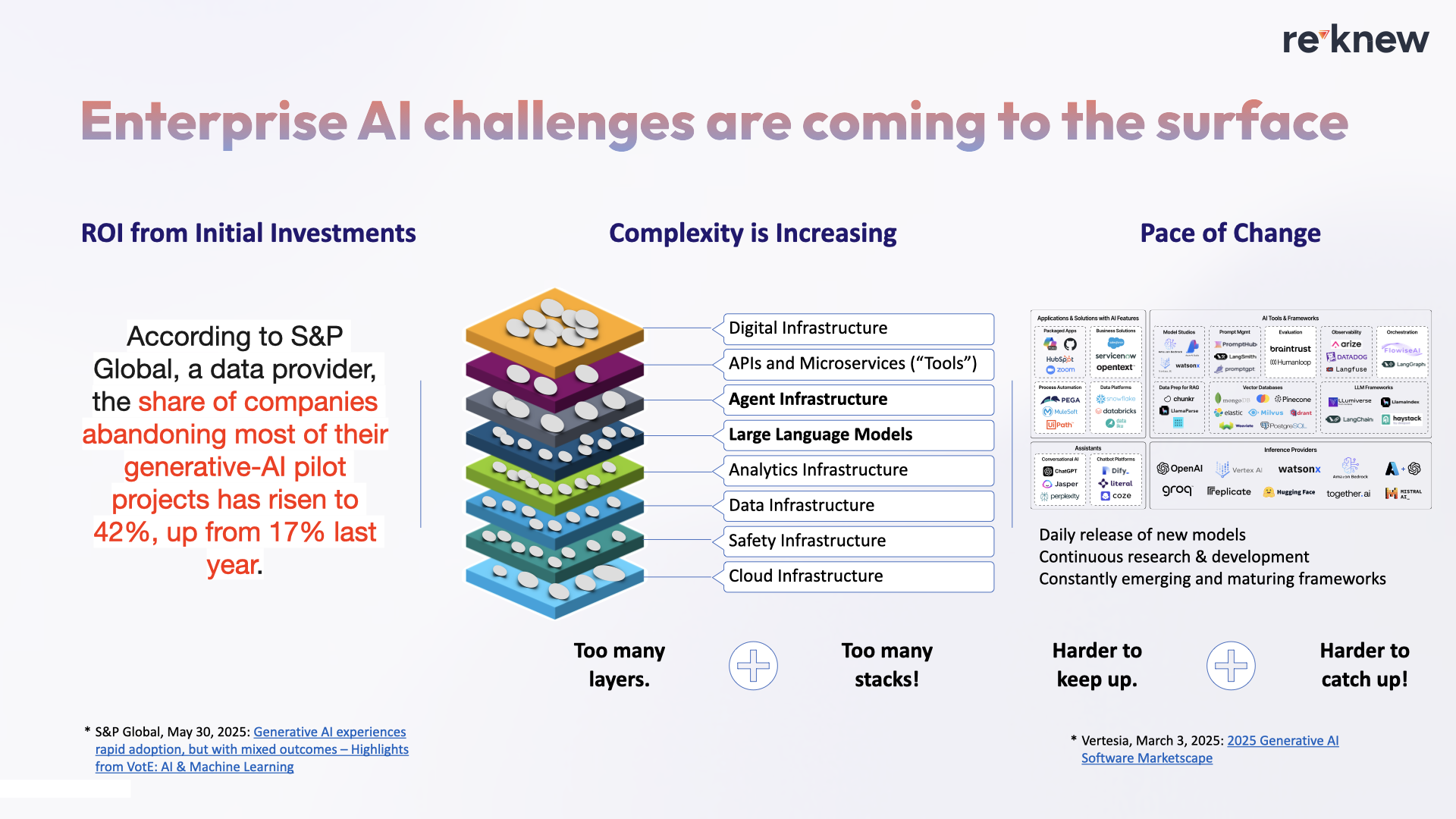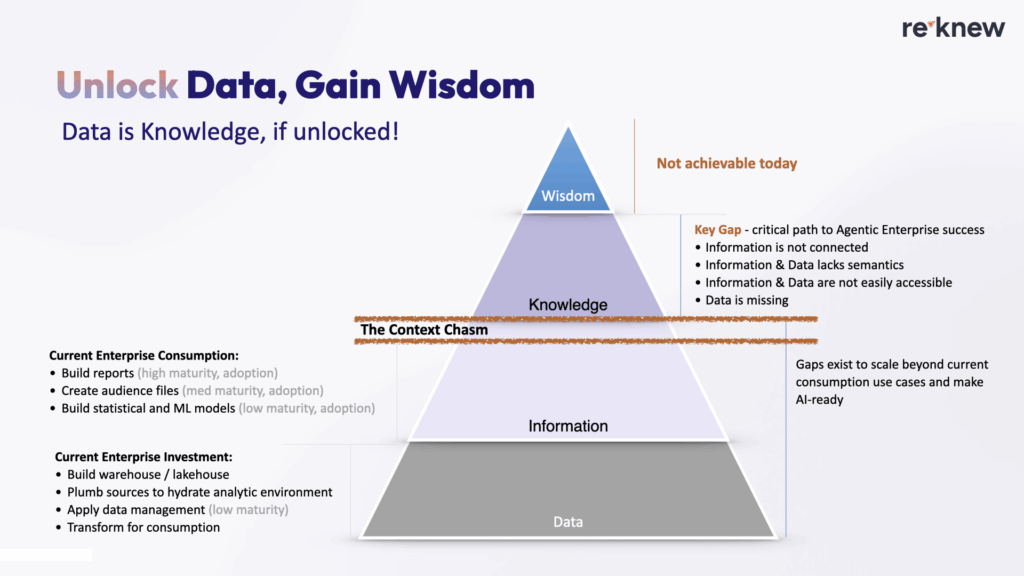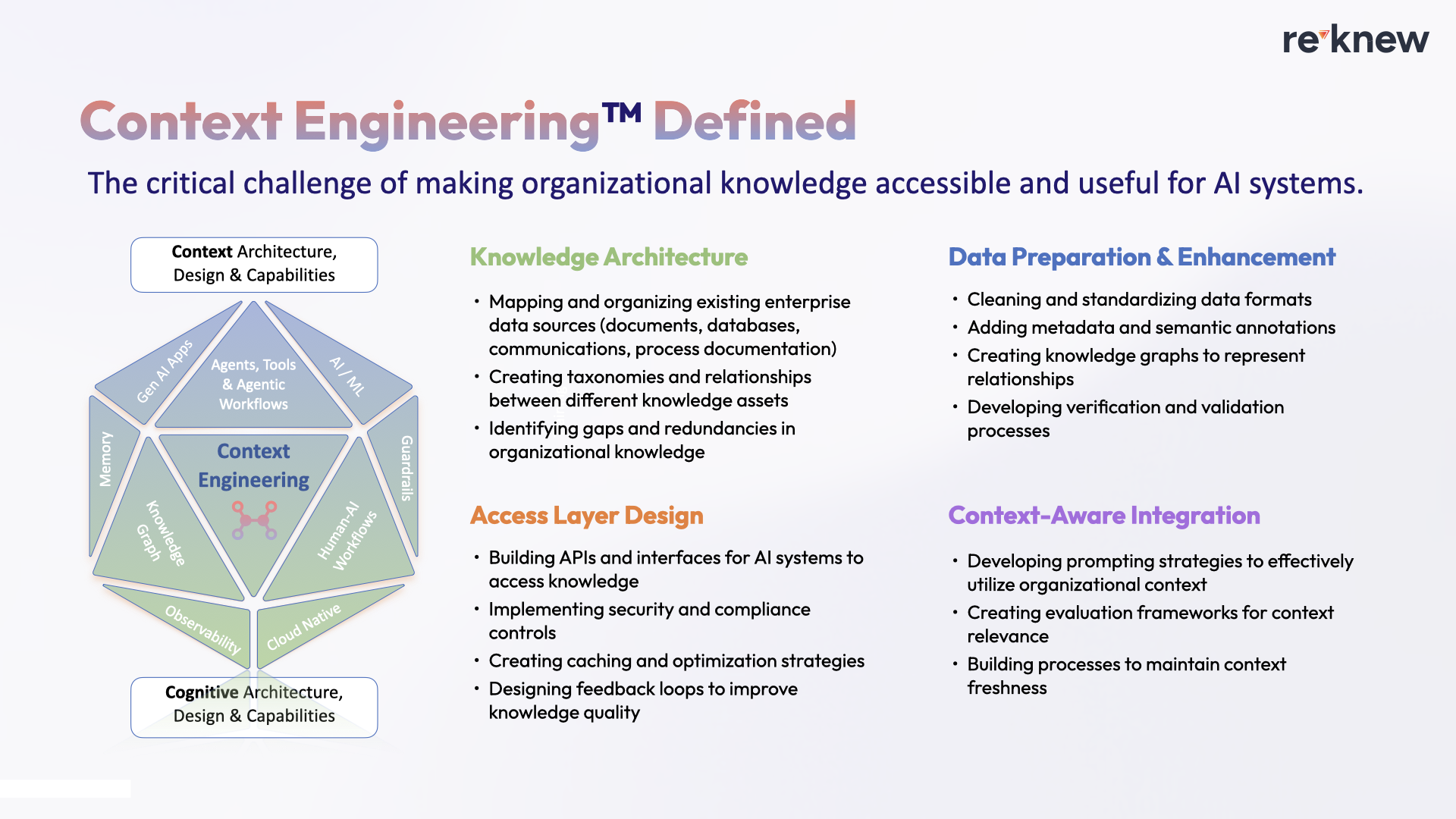






Back to Perspectives
If your AI efforts are failing, it’s likely due to lack of context. ReKnew’s Context Engineering™ approach is helping Enterprises overcome the Context Chasm.

Enterprises have been rushing to build GenAI-based solutions over the last 18 months, fueled by chasing the hype curve, responding to the push from their Board, CEO, and other well-meaning executives, and the need to stay competitive.
The rush to adopt a complex set of technologies, coupled with high expectations for agent-driven efficiency and a wave of AI experiments, is driving a sharp rise in the failure rate. The lack of skills and talent to build this future at the current pace of change and innovation are contributing factors. Brute-force tactics and prompt engineering are revealing their limitations.
According to a recent S&P Global study, the share of companies abandoning most of their generative-AI pilot projects has risen to 42%, up from 17% last year.
Source: S&P Global Study

To solve a problem, we must first identify it and name it. The Context Chasm is our label for the distance between the current set of data and information available and the depth and breadth of the gap to knowledge.
Data is undoubtedly crucial, but simply providing data is not sufficient. Data in the age of Gen AI must also be reframed and recalibrated beyond the boundaries of the data warehouse or analytic environment.
Everything turns into “data” when it is fed into an AI use case. For Gen AI, this includes documents, images, audio, video, websites, structured and unstructured data. Most of this data is contextualized by humans, who have for years seen and used this information and implicitly applied meaning to it.
Machines on the other hand, struggle to make much sense of information fed to them unless it’s properly contextualized. Just ask a traditional machine learning data scientist about the lack of labeled data before Gen AI to get a sense of how the context problem has morphed!
Transforming raw organizational knowledge into easily accessible, semantically rich, and actionable context empowers AI systems to understand, reason, and perform tasks with greater accuracy and efficiency across diverse applications. Incorporating semantic layers, knowledge graphs and accessibility tools to expose rich, connected knowledge to AI Agents creates confidence, grounding and the right guardrails to mitigate hallucinations. These capabilities are absent in many organizations as they have not served a purpose in the past, making solving this layer that much more difficult.
At ReKnew, we saw this challenge early – rooted in our founders’ firsthand experience leading complex data, AI and technology-driven business transformations at large Enterprises.
As architects and builders of sophisticated GenAI solutions, we felt the pain ourselves! The issue wasn’t just about data availability or technology capability – it was fundamentally about accessing and applying knowledge effectively.
We were not alone. Leading figures in GenAI including Harrison Chase, Andrej Karpathy, Dr. Ethan Mollick and others have begun advocating for context engineering. In fact, Anthropic’s motivation for the Model Context Protocol (MCP) stems from the same observation: “Models are only as good as the context provided to them” – Anthropic, AI Engineer Summit 2025

LLMs and Agents are knowledge systems – they feed off knowledge and they can help solve knowledge problems. Simply feeding data to an LLM is trivial, but ineffective as the scope and scale of the use case grows in complexity.
This naive approach is leading Enterprises to face the failures without a constructive framework.
Context Engineering™ builds on top of Data Engineering to focus on turning Data and Information into Knowledge for the primary purpose of enabling successful AI solutions. It fills the gap with the current Prompt Engineering approach, making it suitable for Enterprise use cases that require compliance and robustness while dealing with complexity,
Without context, even the most powerful AI models, agents and tools, lose their effectiveness.
Manually inserting context into hand-crafted prompts (i.e. “prompt-and-pray”) may be good for proof-of-concepts and one-off simple use cases, but will not scale to hundreds or thousands of Enterprise Agentic use cases.
Codifying context in a meaningful and systemic approach requires careful thinking, planning, architecture and design expertise.
Designing for scale (ex: thousands of Agents orchestrated into workflows performing varieties of tasks with and without human-collaboration) is a daunting, but achievable goal. Shaping and making Enterprise data accessible to Gen AI models and Agents is the critical foundation.
We have already demonstrated how this can be a turning point to our Enterprise clients.
At ReKnew, our Context Architecture complements traditional data and technology architectures to enable a successful AI strategy that delivers on Enterprise outcomes. Our Context Architects and Context Engineers are helping Enterprises navigate this emerging field and understand what it takes to successfully turn vast amounts of data into context-ready knowledge fit for AI.
Contact us to learn more about Context Engineering™ and how ReKnew can help prevent hope from turning into despair. Let’s grab a coffee and chat!
Recent Posts


We help organizations reduce inefficiencies, automate workflows, and unlock growth opportunities.

4030 Old Milton Parkway Alpharetta, GA 30005 USA

social@reknew.ai
.svg)
+1(678) 253-2599
© 2025 ReKnew. All Rights Reserved.
